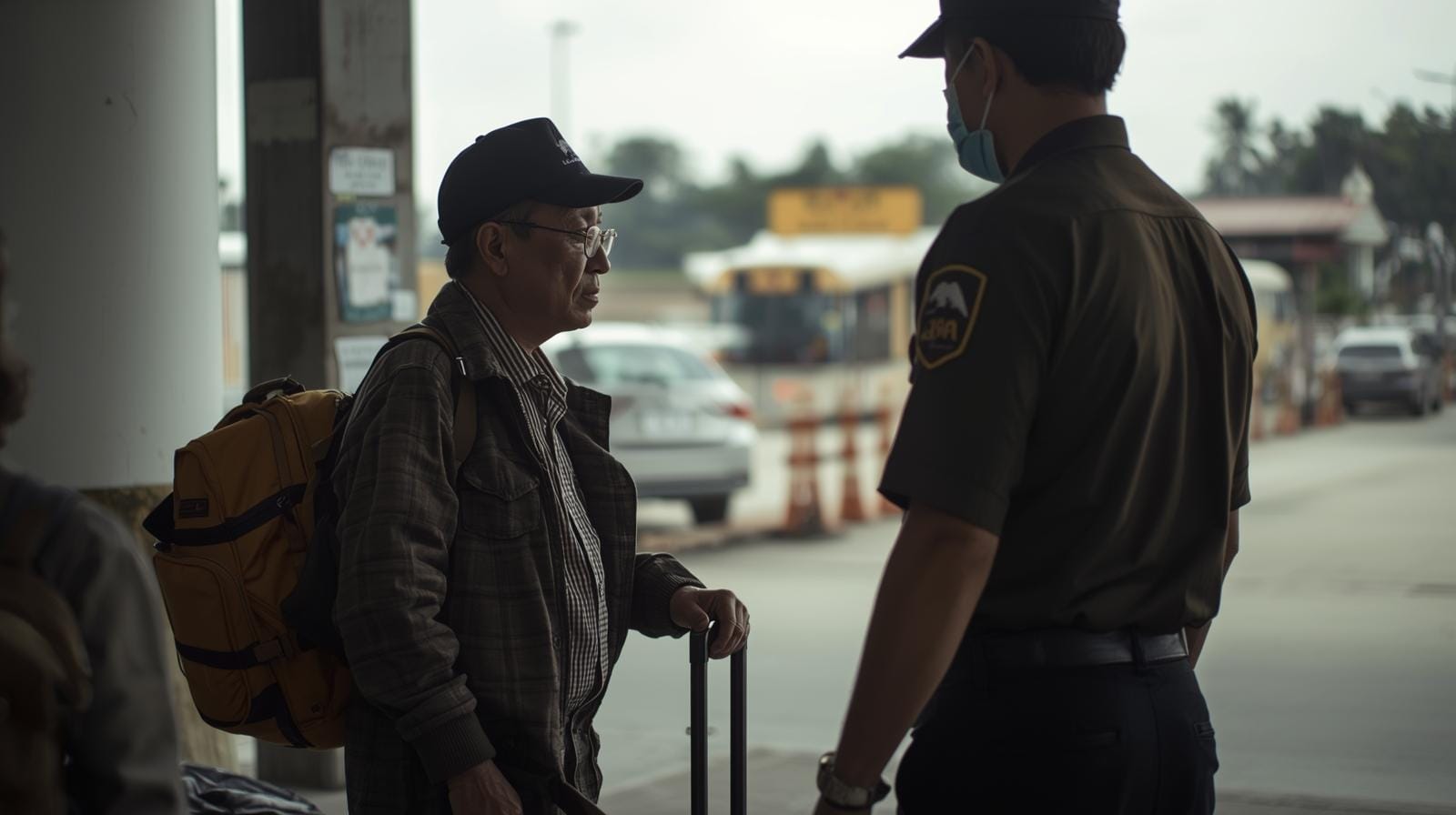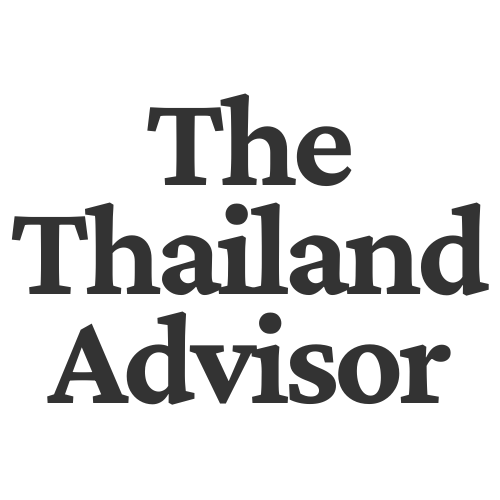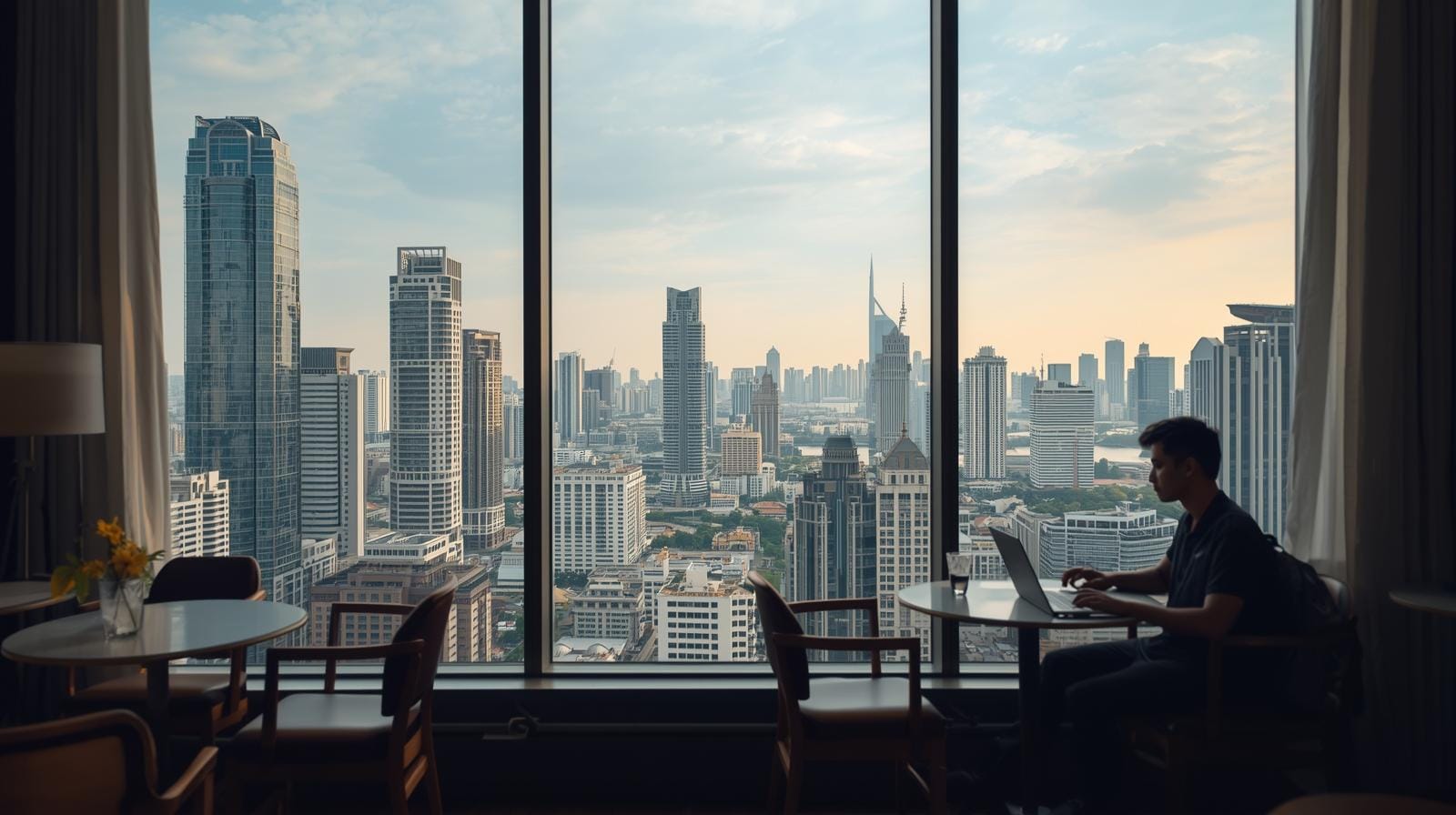Thailand is quietly clamping down on frequent visa-exempt entries (“visa runs”), enforcing new limits that surprise long-stay tourists and digital nomads. This deep-dive explains what’s changing, why, and how it affects expats, tourism, and Thailand’s future.
A 60-Day Welcome, Followed by Second Thoughts
Thailand’s 2024 decision to double its visa-free stay from 30 to 60 days for visitors from 93 countries was a boon to tourism. By expanding the visa-exempt list to more nations and allowing two-month stays (extendable to 90 days), officials hoped longer visits would revive post-pandemic travel. Indeed, the policy “boosted arrivals and spending” in late 2024, helping tourism approach pre-COVID levels. Industry reports cheered the surge, as travelers had more time to explore and pour money into local businesses. The Tourism Authority projected nearly 33.1 million foreign visitors in 2025 – essentially a full recovery. But this extended welcome came with an unintended side effect: some visitors started treating Thailand as a long-term base, blurring the line between tourist and resident.

Ready to take your next step in Thailand?
Connect with vetted local experts for visas, company setup, or property — no spam, no hidden fees.
Many readers have already found trusted local partners through our network.
Yet even as tourism rebounded, Thai officials grew uneasy. Signs of misuse of the generous 60-day visa waiver cropped up within months. By late 2024, whispers in government circles warned that the policy might be getting abused. Travelers on the 60-day exemption were “engaging in non-tourism activities” – effectively living or working in Thailand without the proper visa. Remote workers set up shop on tourist stamps, and some visitors strung together back-to-back stays by doing quick visa runs to neighboring countries. The welcome mat was being taken advantage of, and the data started to raise eyebrows.

Red Flags Officials Monitored
Direct regulatory interpretation of 60-day exemption misuse.
Officials were tracking behavioural patterns that signalled residency and unlicensed work rather than tourism.
| Misuse Sign | What Officials Saw |
|---|---|
| Working on Tourist Visas | Remote work and low-visibility business activity under a tourist entry — treated as misuse of a visa-free stay. |
| Frequent Visa Runs | Quick successive exits and re-entries indicated semi-residency behaviour rather than genuine tourism. |
| Bypassing Licensed Sectors | Condos replacing hotels during “tourist” stays elevated complaints of unfair use of the 60-day policy. |

Risk Triggers for Long-Stay Visitors
Same facts reframed as practical warnings for travellers.
If your daily routine resembles a job rather than travel, immigration systems will treat it accordingly.
Multiple rapid re-entries no longer fly under the radar; they trigger the semi-resident classification.
Long-stay accommodation choices are read as intent — hotels equal tourism, condos imply residency.
If your stay pattern leans toward long-term living, a structured visa strategy is safer than testing immigration tolerance.
The Thailand Advisor connects readers with vetted, licensed partners for compliant long-stay options.
Get ConnectedIt wasn’t just anecdotes triggering alarm. In October 2025, the Ministry of Tourism and Sports convened a high-level review of the 60-day visa-free scheme. Officials openly wondered if Thailand’s “visa waiver has gone too far”. The tourism minister quipped that while Thailand loves long-staying guests, “please stop pretending to be digital nomads forever.” The message was clear: the visa exemption was meant to boost tourism, not to provide de-facto residency for online freelancers or unlicensed tour guides. The uncomfortable truth is that Thailand’s hospitality had been a double-edged sword – boosting the economy on one side, while inadvertently opening a loophole for quasi-expats on the other. Facing this reality, authorities pivoted from celebration to second thoughts about the open-arms approach. A formal rollback to 30-day stays was put on the table, aiming to “balance promoting tourism with enforcing immigration laws.”


60-Day Exemption Expansion
A monochrome, data-first breakdown of the 2024 policy shift.
Thailand extended visa-exempt stays from 30 to 60 days and widened eligibility to 93 countries, up from 57. A structural shift designed to accelerate tourism recovery.

The Policy Shift Through a Strategic Lens
Same numbers, but focused on exposure, not just opportunity.
Doubling stays to 60 days and opening to 93 countries gave Thailand a sharper tourism edge. Longer visits meant higher per-trip spend and easier itinerary planning for long-haul markets.
The same flexibility now fuels concerns: extended digital nomad stays, blurred tourist/work boundaries, and pressure from sectors claiming the policy distorts fair competition.
A policy that once looked untouchable is now on the table. Anyone betting plans or revenue on the 60-day waiver needs an active information pipeline, not assumptions.
Policy winds in Thailand shift fast — from quiet rule tweaks to sudden enforcement crackdowns and blacklist drives.
The Thailand Advisor tracks these changes and connects readers with vetted immigration and relocation partners when expert interpretation is critical.
Get ConnectedA short intake form lets TTA route your case to an appropriate licensed partner and keep you ahead of rule changes.
Crackdown Reality: Expats Feel the Squeeze
By early 2025, Thailand’s welcome to perpetual tourists had turned into a quiet clampdown. Immigration officers, once lenient, received internal directives to scrutinize frequent visitors. Unofficially, many border posts began enforcing a “two strikes” rule: travelers attempting more than 2 visa-exempt entries per year began encountering pushback. There’s no new law etched in stone – rather, a behind-the-scenes policy shift empowering officers to deny entry if they suspect someone is using visa waivers to reside in Thailand. In practice, a backpacker who hopped in and out all year might suddenly be stopped and asked for proof of a booked flight home, or outright refused entry on their third visit. “Visa run” veterans started trading anxious reports: the game had changed.
One recent example illustrates the new reality. Alex, an American web developer, fell in love with Thailand and spent 50 days in Phuket and 40 days in Chiang Mai earlier this year on visa exemptions. When he landed in Bangkok for a planned winter stay – his third entry of the year – immigration pulled him aside. Noticing Alex’s passport brimmed with Thai entry stamps, officers grilled him about his purpose. Lacking a long-term visa or work permit, Alex was politely told he’d “visited too often” and was put on the next flight out. Stunned, he ended up in Vietnam – which, ironically, now offers a 90-day e-visa welcoming digital nomads with open arms. Alex’s story is increasingly common: Thailand’s once-forgiving border is tightening, catching long-stay travelers off guard and diverting them to more lenient neighbors.
Micro Case Study: Stranded at Suvarnabhumi – After two long visits on visa waivers, a Canadian graphic designer tried to re-enter Thailand in mid-2025 for another two-month stay. Immigration records flagged her frequent pattern. She was questioned for an hour and ultimately denied entry as a “visa runner.” Left stranded at Bangkok’s Suvarnabhumi Airport, she had to book a last-minute flight to Malaysia – where, as it happens, Canadians get 90 days visa-free with no fuss. Her lesson? Thailand’s tolerance for back-to-back tourist stays has evaporated overnight.
For the cohort of expats, nomads, and semi-residents who relied on continuous tourist entries, this crackdown has created whiplash. “I wish they’d just announced a rule, instead of me finding out at the airport,” our Canadian traveler later remarked. The policy might be quiet, but its effects are loud and personal. Where most analyses go wrong is assuming these visa runners contribute nothing to Thailand. In reality, many rent apartments, patronize cafes and coworking spaces, and form ties with local communities. The uncomfortable truth is that by slamming the door on them without warning, Thailand risks collateral damage: lost income for local landlords and businesses, and a hit to its image among the very remote workers it once courted.

Unofficial Two-Entry Limit: What Frequent Visitors Are Reporting
Visa-exempt travel patterns now under tighter scrutiny
Travellers relying on visa-exempt entries are confronting a pattern: immigration officers routinely challenge third entries within the same year. Not law, but consistently enforced.
| Factor | Observed Reality |
|---|---|
| Number of visa-exempt entries tolerated | Two per year, informally enforced |
| Risk on third attempt | High scrutiny; refusal increasingly common |
| Why enforcement tightened | Crackdown on long-stay “visa runs” |
| Preferred alternative | Long-term visas, legitimate onward plans |

Why Third Visa-Exempt Entries Are Failing: A Risk Diagram
A structural look at the tightening border logic
Officers treat this as normal tourist behaviour.
Patterns resembling long-stay workarounds are flagged.
Outcome ranges from extended questioning to outright refusal.
Frequent visitors effectively forced to formalise their stay.
Visa-exempt rules shift without announcement. TTA connects readers with vetted partners who monitor policy changes in real time.
Get ConnectedYet from the Thai government’s perspective, the logic is straightforward: crack down on those gaming the system to push them into proper visa channels. If a digital nomad truly wants to stay, they’re nudged to apply for the official 5-year “Digital Nomad” visa (DTV) or the 10-year Long-Term Resident visa (LTR) – programs explicitly designed to attract skilled professionals and wealthy retirees.
The real risk here is that legitimate, law-abiding visitors get swept up in the strict net meant for abusers. A family visiting multiple times a year to spend time in their Thai condo, or a freelancer who split time between Thailand and Bali, might suddenly face an unexpected “No Entry” stamp. Thailand’s image as an open, inviting destination could erode if social media buzz fills with stories of surprised refusals at the border. After all, in tourism, reputation is everything – and rumors of a hardline immigration stance can spook even casual vacationers.


Unofficial “Two-Entry Rule” & Timeline Overview
Policy signals from 2024–2025
Thai immigration officers increasingly apply an unofficial cap of two visa-exempt entries per year, with heavier scrutiny on the third. The pattern isn’t legislated, but field reports indicate it’s now routine practice.
| Date | Policy Change or Action | Outcome |
|---|---|---|
| Jul 2024 | 60-day visa waiver launched; stay length doubled; eligibility expanded. | Tourist arrivals jump; misuse becomes visible. |
| Late 2024 | First misuse warnings; remote work + repeated re-entry patterns flagged. | Talk of reverting to 30-day rules resurfaces. |
| Mid 2025 | Unannounced crackdown; guidance to scrutinise >2 entries/year. | Denied-entry cases appear; “visa runners” shift behaviour. |
| Oct 2025 | Official review meeting; evaluating impacts and potential rollback. | Policy revision possible in 2026; uncertainty increases. |

How Thailand Quietly Tightened Visa-Exempt Entry
A structural view of enforcement logic
The 60-day waiver created a surge in long-stay tourism. But repeated border hops blurred the line between visitors and undeclared remote workers. Immigration responded with operational, not legislative, controls: officers were told to assess intent, frequency, and stay patterns.
The result: a de-facto threshold of two visa-exempt entries per year. The third is where scrutiny spikes, and denial becomes plausible. The government’s late-2025 review signals potential tightening in 2026.
If your travel pattern risks triggering the unofficial cap, vetted immigration partners can help you evaluate safer strategies. TTA connects readers with trusted experts.
Get ConnectedAs a policy analyst, I see the crackdown as part of a broader recalibration. Thailand is effectively saying: if you want to stay long-term, show your commitment. Over the past year, the government hasn’t just tightened tourist entries; it’s also rolled out new options for bona fide expats. The LTR visa, for instance, lets wealthy foreigners lock in a 10-year stay by investing $500,000 in property. At the same time, business regulations are being relaxed – after decades of protectionism, officials agreed (in principle) in 2025 to lift foreign ownership caps in certain industries. The strategy is clear: make Thailand more attractive to “good” foreigners (investors, entrepreneurs, genuine retirees) while filtering out those perceived as freeloaders. I applaud the intent to bolster quality and compliance, but I worry about execution. Black-and-white rules at the border don’t always capture the gray reality of global citizens. The risk is a policy that’s too blunt – one that deters the very talent and capital Thailand seeks by creating a climate of uncertainty.

Quality vs. Quantity – The High-Stakes Balancing Act
Thailand’s visa crackdown raises a fundamental question: is the country trading quantity for quality in its tourism and expat mix, and at what cost? Officials argue that tightening the door to visa runners will “ensure a level playing field” for Thai businesses and preserve security. In their eyes, a smaller number of high-value, rule-abiding foreign residents is better than hordes of backpackers milking tourist visas to live on the cheap. Indeed, signs already show Thailand pivoting to upscale foreigners – from the Phuket property boom fueled by Chinese and Russian buyers to special visas for wealthy retirees. The government’s long-term aim seems to be a curated kind of foreign presence: investors, professionals, and genuine vacationers, rather than indefinite drifters. Where most analyses go wrong is assuming Thailand can tighten immigration with zero fallout.

The reality is more complex. Tourism remains a pillar of Thailand’s economy, contributing ~18% of GDP pre-pandemic. Even as the country seeks “quality tourists,” it can ill afford to scare away too many visitors in general. Already, after the initial post-Covid boom, Thailand’s travel recovery is hitting headwinds – 2025 could see the first year-on-year drop in arrivals since reopening. With Chinese tourism still below expectations and global uncertainty, every segment of travelers counts. If even a fraction of would-be long-stay visitors choose Vietnam or Malaysia instead (countries whose visa policies are currently more welcoming), that could nip Thailand’s fragile rebound. Vietnam, for one, introduced a 90-day e-visa in 2023 that is explicitly friendly to remote workers, and is toying with a 10-year “golden visa” for investors. Malaysia, meanwhile, quietly lets many nationals stay 90 days visa-free and launched its “DE Rantau” nomad visa to lure tech workers. These regional competitors are eager to soak up any talent or tourism that Thailand pushes away.

The real risk here is that Thailand’s hardline stance overshoots, inadvertently driving away productive expats and entrepreneurs. If a tech startup founder or an investor gets burned by a refused entry, they might opt to build their life (and business) elsewhere – taking jobs and spending with them. There’s also reputational risk: a perception that Thailand is becoming bureaucratically hostile to foreigners. That would undermine the country’s charm offensive in other areas, like new investment incentives and one-stop service centers for expats. As one Bangkok economist cautioned, “the entry bar has actually risen: get the right visa, or you’ll find the banking system closed off.” In short, Thailand must be careful that its pursuit of “quality” foreigners doesn’t inadvertently signal that the door is shut except to the ultra-rich.
On the other hand, if managed deftly, the crackdown could yield long-term benefits. It might indeed discourage those who contribute little or flout laws (like working on tourist status) while nudging serious long-term folks onto proper visas that come with oversight and economic contributions. It could also reassure Thai citizens that immigration isn’t a free-for-all, easing social pressures. The coming months will be telling. Officials have said any changes – such as reducing visa-free stays or formalizing entry limits – will be announced in advance. That’s critical: transparency can prevent airport surprises.

Thailand’s 2025 Tourism Surge
Monochrome data card built for policy context.
With 33.1 million visitors projected, Thailand approaches pre-pandemic highs. That scale explains the government’s posture: encourage high-volume tourism while preventing a minority from effectively using tourist entries as soft residency.

Tourism Volume vs. Policy Boundaries
Strategic interpretation of the same data.
At this scale, Thailand doesn’t have a tourism “boom” — it has a structural dependency. More visitors amplify opportunity, but also amplify every enforcement blind spot.
Policymakers must protect the system from long-stay misuse without signalling that genuine travellers are unwelcome. Maintaining that dual message is becoming harder as volumes rise.
When tens of millions enter the pipeline, even minor rule adjustments cascade into real-world consequences — from airport questioning to sudden shifts in permitted stay durations. Anyone planning extended time in Thailand should monitor these pivots, not react after the fact.
Policy shifts in Thailand rarely come with advance notice. Enforcement trends can flip in a week — sometimes overnight.
The Thailand Advisor does not provide immigration services. Instead, TTA connects readers with vetted partners and issues timely alerts when the rules move.
Get ConnectedA short form ensures your query is routed to the right licensed specialist — no noise, no delays.
What This Means for You
The key takeaway for our readers is that Thailand is tightening its rules on informal long stays. If you plan to spend extended time in Thailand, you’ll need to be proactive: secure the right visa upfront or adjust your travel pattern. Relying on endless visa runs is no longer a safe bet. In positive terms, Thailand is still welcoming – but increasingly on its own terms (encouraging investors, retirees, and skilled professionals). The key takeaway for our readers is that savvy expats should consider formal long-term visa options (like LTR or investment visas) or prepare backup plans in neighboring countries if Thailand’s policies don’t favor your situation. By understanding the new limits and planning accordingly, you can avoid unpleasant surprises at the border.



Ready to take your next step in Thailand?
The Thailand Advisor connects you with vetted local experts — trusted professionals who understand Thailand’s systems, pricing, and process.
Whether your goal is visa approval, company setup, or property investment, we’ll guide you with clarity — no spam, no hidden fees.
Answer a few quick questions to match with the right consultant for your goals.
Many readers have already found trusted local partners through our network.









